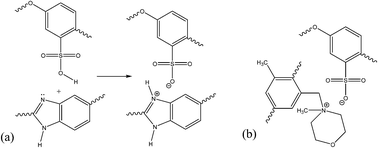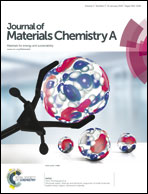Novel morpholinium-functionalized anion-exchange PBI–polymer blends
Abstract
Novel morpholinium-functionalized anion-exchange blend membranes are presented in this study. The blended membranes consist of highly brominated poly(aryl ether) (PAE-Br) or poly(2,6-dimethyl-1,4-phenyleneoxide) (PPO-Br), partially fluorinated polybenzimidazole (F6-PBI) as the polymer matrix and/or a sulfonated polyethersulfone from 1,1′-biphenyl-4,4′-diol and potassium 5,5′-sulfonylbis(2-fluorobenzenesulfonate), abbreviated in this study as SAC. One of the manufactured blend membranes (IEC: 2.4 mmol g−1) had a better alkaline stability than the Tokuyama membrane A201. In addition, excellent thermal stability and moderate water uptake were observed for the blend. The enhanced thermophysical properties were ascribed to the PBI matrix, whereas the high bromination degree of the ionomer contributed to the high ion-exchange capacities and conductivities obtained. The significantly increased chemical stability noted for these blends can partially be attributed to supplementary ionic cross-links formed between acidic and basic components. These results, combined with the ability of PPO-Br and PAE-Br to form macroscopically homogeneous blends with PBIs, resulting in stable and flexible polymer films, reiterate the potential suitability of the presented membranes as polymer electrolytes for electrochemical applications such as alkaline fuel cells.


 Please wait while we load your content...
Please wait while we load your content...